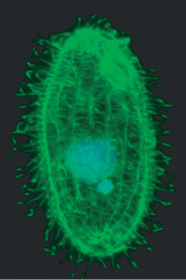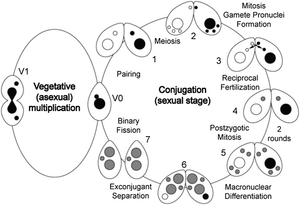Tetrahymena thermophila
Classification
Higher order taxa
Eukaryota; Chromalveolata; Ciliophora; Oligohymenophorea; Hymenostomatida; Tetrahymenidae
Species
Tetrahymena thermophila
Description and Significance
Tetrahymena thermophila is a large, motile, phagocytic, unicellular eukaryote. The organism is about 20x50µm. T. thermophila live in temperate freshwater environments.
Describe the appearance, habitat, etc. of the organism, and why you think it is important.
Genome Structure
T. thermophila contain two nuclei, a macronucleus and a micronucleus. Each has been sequenced[1]. The macronucleus is ultimately derived from the micronucleus. The micronucleus is diploid and contains 5 pairs of chromosomes. The macronucleus contains 45 copies of 275 chromosomes formed by fragmentation, as well as 9000 copies of the rRNA gene. The macronucleus contains 15% less genetic information than the micronucleus, which represents noncoding DNA and transposable elements. The macronucleus is kept intact through asexual reproduction by telomerase activity. Additionally the mitochondrial genome has been sequenced [2].
Cell Structure
Tetrahymena thermophila has all the basic structures of animal cells except intermediate filaments.
Metabolism
How it gains energy; what important molecules it produces.
Life Cycle
The presence of the two nuclei reflects T. thermophila’s ability to reproduce both sexually and asexually. During vegetative growth the macronucleus is transcribed, translated and transmitted to the next asexual generation by mitosis. Food stress induces T. thermophila to reproduce sexually, producing pronuclei by meiosis of the micronucleus and exchange with a cell of a different mating type. The macronucleus is ultimately derived from the micronucleus.
Ecology and Pathogenesis
Habitat; symbiosis; biogeochemical significance; contributions to environment.
If relevant, how does this organism cause disease? Human, animal, plant hosts? Virulence factors, as well as patient symptoms.
References
Author
Page authored by Hannah Pak and Luke Pryke, students of Prof. Jay Lennon at Indiana University.


